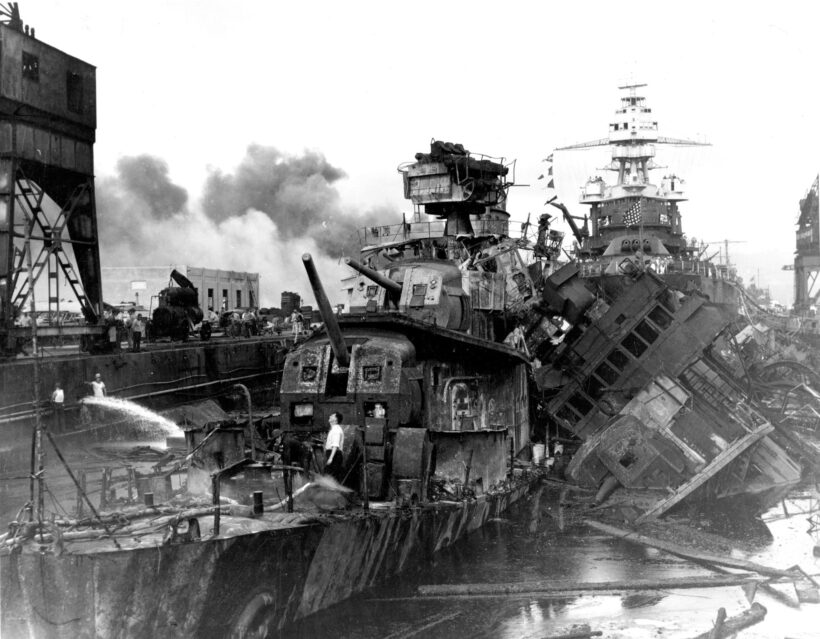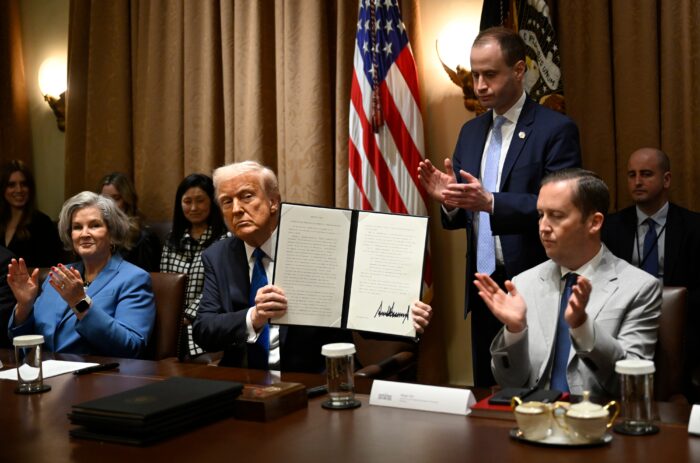
Destroyers Downes and Cassin after the attack on Pearl Harbor. Both were damaged beyond repair but their machinery and equipment was salvaged and installed onto newly built ships and were given their names and hull numbers. The Pennsylvania behind them only suffered light damage.
redo Jump to...
print Print...
(from VFW .org) — Dec. 7 is National Pearl Harbor Remembrance Day, and the Veterans of Foreign Wars (VFW) encourages all Americans to pause and reflect on the attack 83 years ago that changed the course of history and brought together the nation to defend our sovereignty, confront tyranny and win back freedom around the world.
The Japanese attack resulted in more than 3,500 dead or wounded, and while it was a day of immense tragedy, it would also become a day which showcased America’s unbreakable spirit. The attack has come to stand as a testament to future generations that while our homeland may be attacked, our enemies will never defeat our republic or our way of life.
On this National Pearl Harbor Remembrance Day, the more than 1.4 million members of the VFW and its Auxiliary ask everyone to take a moment to remember and be inspired by all who served and sacrificed.
Questions
Read/watch the “Background” and “Resources” below.
1. What surprised you most about the attack on Pearl Harbor? Explain your answer.
2. What do you think every student should know/learn about Pearl Harbor? Explain your answer.
Background
THE JAPANESE ATTACK ON PEARL HARBOR killed 2,403 U.S. personnel, including 68 civilians, and destroyed or damaged 19 U.S. Navy ships, including 8 battleships.
The attack on Pearl Harbor was a surprise military strike conducted by the Imperial Japanese Navy against the United States naval base at Pearl Harbor, Hawaii on the morning of December 7, 1941.
- The base was attacked by 353 Japanese aircraft in two waves, launched from six aircraft carriers.
- Four U.S. Navy battleships were sunk (two of which were raised and returned to service later in the war) and the four other battleships present were damaged*
- The Japanese also sank or damaged three cruisers, three destroyers, an anti-aircraft training ship and one minelayer.
- 188 U.S. aircraft were destroyed, 2,402 personnel were killed and 1,282 were wounded.
- The power station, shipyard, maintenance, and fuel and torpedo storage facilities, as well as the submarine piers and headquarters building (also home of the intelligence section) were not attacked.
- Japanese losses were light, with 29 aircraft and five midget submarines lost, and 65 servicemen killed or wounded. One Japanese sailor was captured.
- The following day (December 8) the United States declared war on Japan.
- Subsequent operations by the U.S., as well as the Axis alliance, prompted Germany and Italy to declare war on the U.S. on December 11, which was reciprocated by the U.S. the same day.
- Despite numerous historical precedents for unannounced military action, the lack of any formal warning by Japan, particularly while negotiations were still apparently ongoing, led to President Franklin D. Roosevelt proclaiming December 7, 1941, “a date which will live in infamy.” (exerpted from wikipedia)
*About the Battleships:
- USS Arizona (Kidd’s flagship): hit by four armor-piercing bombs, exploded; total loss. 1,177 dead.
- USS Oklahoma: hit by five torpedoes, capsized; total loss. 429 dead. Refloated November 1943; capsized and lost while under tow to the mainland May 1947.
- USS West Virginia: hit by two bombs, seven torpedoes, sunk; returned to service July 1944. 106 dead.
- USS California: hit by two bombs, two torpedoes, sunk; returned to service January 1944. 100 dead.
- USS Nevada: hit by six bombs, one torpedo, beached; returned to service October 1942. 60 dead.
- USS Tennessee: hit by two bombs; returned to service February 1942. 5 dead.
- USS Maryland: hit by two bombs; returned to service February 1942. 4 dead (including floatplane pilot shot down).
- USS Pennsylvania (Kimmel’s flagship): in drydock with Cassin and Downes, hit by one bomb, debris from USS Cassin; remained in service. 15 men killed (including her executive officer), 14 missing, and 38 wounded.
In a speech Dec. 8, 1941 asking Congress to declare war on Japan after the bombing of Pearl Harbor, President Franklin D. Rooselvelt said in part:
“Yesterday, December 7, 1941 – a date which will live in infamy – the United States of America was suddenly and deliberately attacked by naval and air forces of the Empire of Japan… No matter how long it may take us to overcome this premeditated invasion, the American people will through their righteous might win through to absolute victory… With confidence in our armed forces – with the unbounded determination of our people – we will gain the inevitable triumph – so help us God. I, therefore, ask that the Congress declare that since the dastardly and unprovoked attack by Japan on Sunday, December 7th, a state of war has existed between the United States and the Japanese Empire.”
-Read FDR’s speech to Congress at fdrlibrary.marist.edu, OR
-Listen to FDR’s speech to Congress at history.com.
Watch President Franklin D. Roosevelt’s speech to Congress on Dec. 8, 1941 the day after the Japanese bombing of Pearl Harbor, in which he asks Congress to declar war on Japan:
Resources
The Japanese attacked Pearl Harbor to cripple the U.S. Pacific Fleet, but America’s aircraft carriers––perhaps the most vital type of warship––were not stationed there on December 7. Not long after the attack, these ships would go on the offensive against the Japanese. (Read about U.S. victories involving aircraft carriers:
See 3 editorials:
- What do you know about Pearl Harbor? and
- Remember Pearl Harbor in 2018
- 8 Tales of Pearl Harbor Heroics
Visit the National Park Service website for Pearl Harbor Remembrance Day.
See previous news articles:
- USS Arizona survivor gets hero’s welcome in return to Hawaii (Dec. 2019)
- Oldest U.S. survivor of Pearl Harbor dies at 106 (Dec. 2018)
- ‘Heroes all’: Survivors mark 76th anniversary of Pearl Harbor attack (Dec. 2017)
- Oldest Pearl Harbor Survivor, 104, Flies Back to Honolulu (Dec. 2016)
Watch a Pearl Harbor video below:
Daily “Answers” emails are provided for Daily News Articles, Tuesday’s World Events and Friday’s News Quiz.



